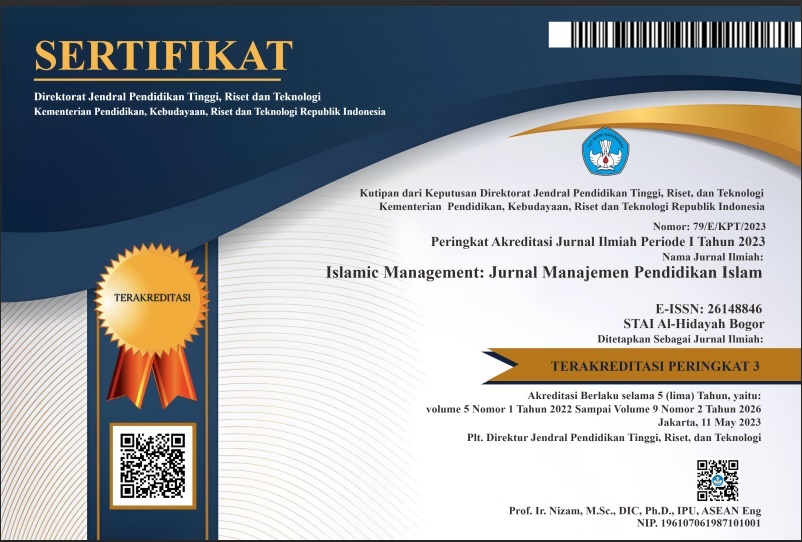LEARNING STRATEGY OF BRAIN RHYTHM METHOD ON AL-QURAN MEMORIZATION OF MTA SURAKARTA HIGH SCHOOL STUDENTS
DOI:
https://doi.org/10.30868/im.v8i01.8044Keywords:
Learning Strategy, Brain Rhythm Method, Memorizing the Al-QuranAbstract
The Brain Rhythm Method is a method of memorizing the Al-Quran that uses tonal rhythm and makhaj rhythm techniques in the memorization process by paying attention to the correct legal rules of recitation. This research aims to test the effectiveness of applying the Brain Rhythm Method in improving the quality of Al-Quran memorization in MTA Surakarta High School students. Some intensive tahfidz students experienced a decrease in enthusiasm for memorizing the Al-Quran. An interesting method was applied, namely the Brain Rhythm Method, which can help improve students' memorization of the Al-Quran. Researchers use a qualitative approach, with descriptive analysis research methods. In this study, researchers interviewed 4 musyrifah tahfidz alumni of Kuntum Indonesia, who taught the Brain Rhythm Method at SMA MTA Surakarta. The research object was 100 intensive tahfidz female students. The results of this research can be concluded that the implementation of the Brain Rhythm Method went smoothly and was proven to be effective in improving understanding and quality in memorizing the Al-Quran. This method can also increase students' enthusiasm for memorizing. And the evaluation results obtained were very satisfying, many students achieved targets and exceeded memorized targets. Of course, all of this is the result of collaboration between all parties involved in implementing the Brain Rhythm Method.
References
Arifin, Z. (2012) Learning Evaluation .Bandung: PT Remaja Rosdakarya Offest
Al-Fattah, A. 2005. 40 Learning Strategies of the Prophet. Yogyakarta: Tiara Wacana. Ramayulis.
Yayasan Kuntum Indonesia, "KUNTUM INDONESIA website," October 26, 2024
Quraish Shihab, Grounding the Qur'an the function and role of revelation in people's lives (Bandung: Mizan, 2009), 46.
Interview (Jannah: 2024, Musyrifah Tahfidz), SMA MTA Surakarta, November 7, 2024
(Interview, Indar :2024), Musyrifah Tahfidz SMA MTA Surakarta, November 8, 2024.
Interview (Choirotunnisa:2024), Musyrifah Tahfidz SMA MTA Surakarta
Interview (Syahla: 2024) Musyrifah Tahfidz SMA MTA Surakarta, November 10, 2024
Interview (Dwi: 2024), Ustadzah Alumni Kuntum Indonesia at SMA MTA Surakarta
Interview (Aisyah, a student of class XI Tahfidz Intensif), November 11, 2024
Interview Salsabila, Musyrifah Tahfidz Alumni Kuntum
Interview (Ataritsna:2024), Intensive Tahfidz student of SMA MTA Surakarta
Interview (Zumrotul: 2024), Head of Tahfidz Program of SMA MTA Surakarta
Hidayatusahiro, F. (2021). Teachers' Efforts in Improving the Quality of Al-Qur'an Memorization with the Brain Rhythm Method at Assaubari Ponorogo Tahfidz House (Doctoral dissertation, IAIN Ponorogo).
Inten, D. N., Aziz, H., Hakim, H. Q. N., & Mulyani, D. (2024). Training on teaching quran memorization through the brain rhythm method as an effort to improve the teaching skills of Madrasah Diniyah teachers in Pangalengan District. Abdimas Siliwangi, 7(2), 293-306.
Aziz, H., Mulyani, D., Inten, D. N., Hakim, H. Q. A. N., Rizqi, A. A., & Az-Zahra, S. S. (2024). The Implementation of the Brain Rhythm Method in Enhancing the Quality of Quran Memorization. AL-ISHLAH: Journal of Education, 16(3), 2925-2938.
Downloads
Published
How to Cite
Issue
Section
Citation Check
License
Copyright (c) 2025 Isnaini Nur Khotimah, Mohammad Zakki Azani

This work is licensed under a Creative Commons Attribution-ShareAlike 4.0 International License.
Authors who publish with this journal agree to the following terms:
- Authors retain copyright and grant the journal right of first publication with the work simultaneously licensed under a Creative Commons Attribution License that allows others to share the work with an acknowledgment of the work's authorship and initial publication in this journal.
- Authors are able to enter into separate, additional contractual arrangements for the non-exclusive distribution of the journal's published version of the work (e.g., post it to an institutional repository or publish it in a book), with an acknowledgment of its initial publication in this journal.
- Authors are permitted and encouraged to post their work online (e.g., in institutional repositories or on their website) prior to and during the submission process, as it can lead to productive exchanges, as well as earlier and greater citation of published work (See The Effect of Open Access).






